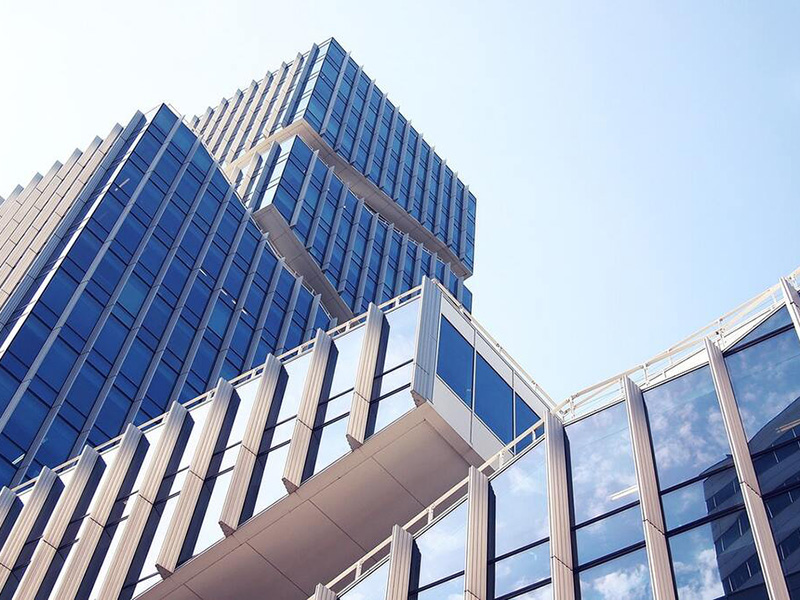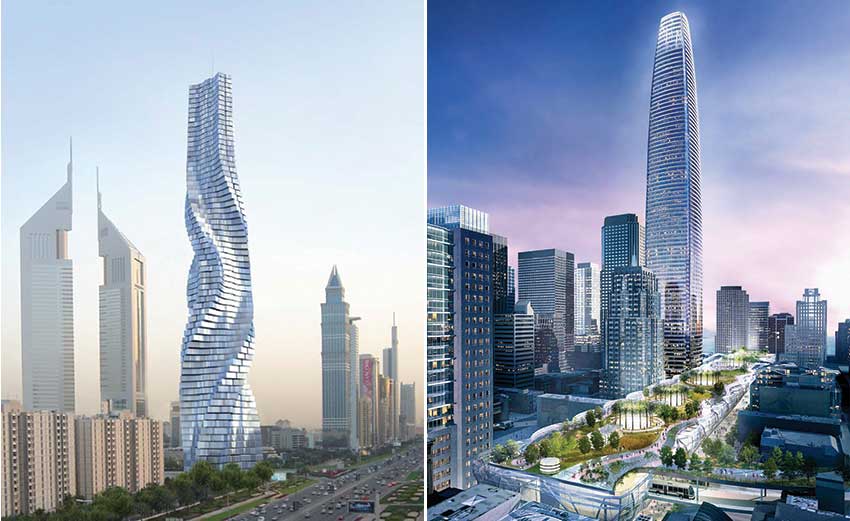
Parisa Esmaeili Moakher Research Graduate ME (Construction & Management), Dr S.S.Pimplikar Professor & Head-Civil Department MIT- Pune
Continued challenges with the availability of fossil fuels and the impact of global warming are pushing building owners and developers toward projects that have a much higher level of energy efficiency .The challenge is that this efficiency needs to be provided, while at the same time supporting the overall building project goals including architectural, operational and occupant comfort .The result is the need for a "high performance" building where the building systems are pushed to deliver more, without necessarily costing more.
The present paper intends to highlight the needs for Green Concept. Many people refuse to go for green construction as they believe it costs more.Through an actual case study, it is demonstrated that in long-term, it would be more beneficial to construct a green building, even though the initial cost is more.
In continuation,the paper tries to give an overall view of the exciting developments taking place on the technology front for intelligent and green buildings, highlighting examples of "best in class" buildings employing green and intelligent technologies. These buildings are dynamic environments that respond to their occupants' changing needs and lifestyles.
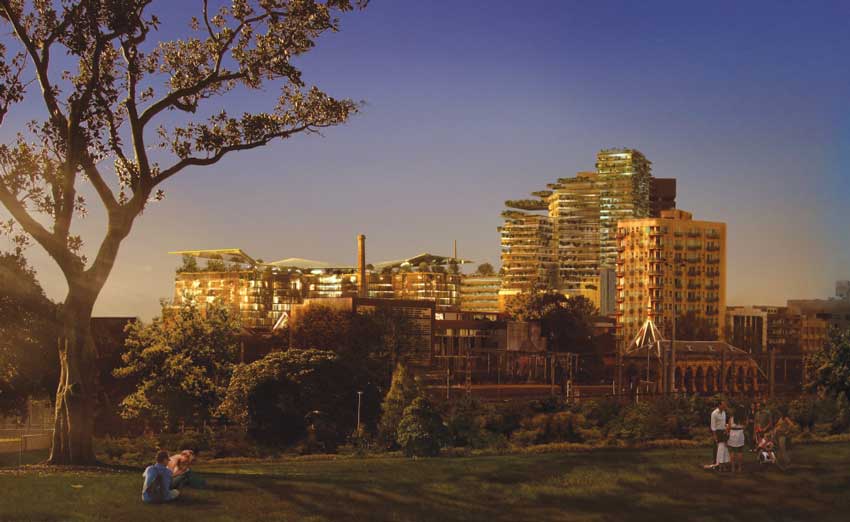
Introduction
A penny saved is a penny earned. A study conducted by Energy Information Administration, (EIA), U.S department of energy indicates that there is a visible trend across the globe wherein the growth rate in total energy consumption has been greater than the population growth rate. In the developed countries, the energy consumption growth is only marginally higher compared to the population growth rate. For example, in US, energy consumption is projected to grow at 0.8%. In contrast, in developing countries like India, population growth rate is expected to grow at 1.3% while the energy consumption rate is 4.3%.This trend would strain the energy sector to a large extent.The construction industry in the country is growing at a rapid pace and the rate of growth is 10% as compared to the world average of 5.2%. Hence energy efficiency in the building sector assumes tremendous importance.Buildings annually consume more than 20% of electricity used in India.
Thus, buildings, as they are designed and used today, contribute to serious environmental problems because of excessive consumption of energy and other natural resources. The close connection between energy use in buildings and environmental damage arises because of energy intensive solutions sought to construct a building and meet it's demands for heating, cooling, ventilation and lighting cause severe depletion of invaluable environmental resources. However, buildings can be designed to meet the occupant's need for thermal and visual comfort at reduced levels of energy and resource consumption. Energy resource efficiency in new construction can be affected by adopting an integrated approach on building design. Thus, an energy efficient building balances all aspect of energy in the building-lighting, space-conditioning, and ventilation–by providing an optimized mix of solar design, energy efficient equipments, and renewable sources of energy. Use of materials with low embodied energy, good landscaping, ratio of built form to open spaces, location of water bodies, proper orientation, forms a major component in energy efficient building design.
Civil engineering considers strength, durability and cost as the main criteria while selecting materials, planning and construction. Architecture gives more stress on aesthetics and comfort and pays attention to fulfilling psychological needs of occupants. Green building techniques seek to conserve and utilize natural resources, emphasize eco-friendly construction and think of minimum carbon footprint on global scale.
Need of Green Concept
The concept of sustainable development can be traced to the energy (especially fossil oil) crisis and the environment pollution concern in the 1970s. The green building movement in the U.S. originated from the need and desire for more energy efficient and environment-friendly construction practices. There are a number of motives to building green, including environmental, economic, and social benefits. However, modern sustainability initiatives call for an integrated and synergistic design to both new construction and in the retrofitting of an existing structure. Also known as sustainable design, this approach integrates the building life-cycle with each green practice employed with a design-purpose to create a synergy amongst the practices used.
Green building brings together a vast array of practices and techniques to reduce and ultimately eliminate the impacts of new buildings on the environment and human health. It often emphasizes taking advantage of renewable resources, e.g., using sunlight through passive solar, active solar, and photovoltaic techniques and using plants and trees through green roofs, rain gardens, and for reduction of rainwater run-off. Many other techniques, such as using packed gravel or permeable concrete instead of conventional concrete or asphalt to enhance replenishment of ground water, are used as well.
While the practices, or technologies, employed in green building are constantly evolving and may differ from region to region, there are fundamental principles that persist from which the method is derived: Siting and Structure Design Efficiency, Energy Efficiency, Water Efficiency, Materials Efficiency, Indoor Environmental Quality Enhancement, Operations and Maintenance Optimization, and Waste and Toxics Reduction. The essence of green building is an optimization of one or more of these principles. Also, with the proper synergistic design, individual green building technologies may work together to produce a greater cumulative effect.
On the aesthetic side of green architecture or sustainable design is the philosophy of designing a building that is in harmony with the natural features and resources surrounding the site. There are several key steps in designing sustainable buildings: specify 'green' building materials from local sources, reduce loads, optimize systems, and generate on-site renewable energy.
Environmental benefits
- Enhance and protect biodiversity and ecosystems
- Improve air and water quality
- Reduce waste streams
- Conserve and restore natural resources
Economic benefits
- Reduce operating costs
- Create, expand, and shape markets for green product and services
- Improve occupant productivity
- Optimize life-cycle economic performance
Social benefits
- Enhance occupant comfort and health
- Heighten aesthetic qualities
- Minimize strain on local infrastructure
- Improve overall quality of life
Life Cycle Cost Analysis
The purpose of an LCCA is to estimate the overall costs of project alternatives and to select the design that ensures the facility which will provide the lowest overall cost of ownership, consistent with its quality and function. The LCCA should be performed early in the design process while there is still a chance to refine the design to ensure a reduction in life-cycle costs (LCC).There are numerous costs associated with acquiring, operating, maintaining, and disposing of a building or building system. Building-related costs usually fall into the following categories:
Only those costs within each category that are relevant to the decision and are significant in amount are needed to make a valid investment decision. Costs are relevant when they are different for one alternative compared with another; costs are significant when they are large enough to make a credible difference in the LCC of a project alternative. All costs are entered as base-year amounts in today's currency; the LCCA method escalates all amounts to their future year of occurrence and discounts them back to the base date to convert them to present values.
Most green buildings cost 0–4% more than the conventional buildings, with the largest concentration of reported "green premiums" between 0–1%. Green premiums increase with the level of greenness, but most LEED buildings, up through gold level, can be built for the same cost as conventional buildings. This stands in contrast to a common misperception that green buildings are much more expensive than conventional buildings. In fact, there is not that much significant difference in average cost for green buildings as compared to non-green buildings.

With the help of a practical example, the above facts are highlighted. Data is collected from the ongoing construction site. The work is construction of the Green Buildings. Data collected is as follows:
- Project Name : Kept Anonymous
- Site Address : Hinjewadi,Pune
= 404480961-361877928 = Rs.4,26,03,000
% increase in cost after Life Cycle Cost Calculation is;
= (4,26,03,000/40,44,80,961)*100 =10.5%
Total saving after 20 years = Rs.4,74,26,400
Installation cost of Green Features after life cycle cost calculation = Rs.3.78,09,333
TOTAL SAVING = 4,74,26,400-4,26,03,000 = Rs.48,23,500
Therefore → Benefit/Cost ratio for Green Features
=4.74,26,400/4,26,03,000 = 1.11>1....Ok
Considering these results, it is suggested that investment in Green Construction should be done, though there is an increase in initial investment.
Building Life-Cycle Cost (BLCC) Programs
BLCC software conducts economic analysis by evaluating the relative cost effectiveness of alternative buildings and building-related systems or components. Typically, BLCC is used to evaluate alternative designs that have higher initial costs but lower operating costs over the project life than the lowest-initial-cost design. It is especially useful for evaluating the costs and benefits of energy and water conservation and renewable energy projects. The life-cycle cost (LCC) of two or more alternative designs are computed and compared to determine which has the lowest LCC and is therefore more economical in the long run. BLCC also calculates comparative economic measures for alternative designs, including net savings, savings-to-investment ratio, adjusted internal rate of return, and years to payback.The software can evaluate Federal, state, and local government projects for both new and existing buildings. While BLCC is oriented toward building-related decisions, it can be used to evaluate alternative designs for almost any project type in which higher capital investment costs and lower future operating-related costs exist.
Integration of IT and Green Technology
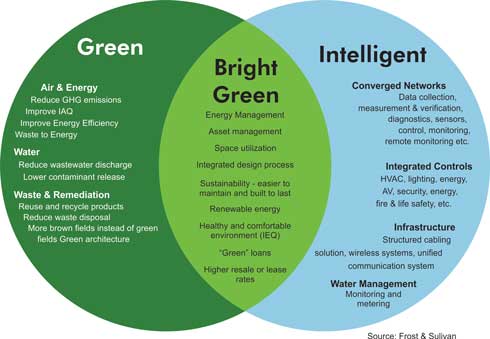
To reduce the energy consumption, the development of the "Green Building" has become the global movement of the building industry to conserve energy, to effectively utilize resource, and to improve the indoor environment control. To minimize the energy consumption and to increase the equipment efficiency are the objectives in development of intelligent green buildings. By installing mini sensors and automatic climate control facilities in the building, the energy consumption can be significantly reduced and the quality of indoor environment can be also improved.
Numerous smart control devices are now available in market which can be deployed easily for ensuring security, comfort and for energy and water conservation. There are restricted access control, intruder alarm, dimmer light controls, Bluetooth, Wi-Fi and/or net enabled smart devices, smoke detector, sensor based plumbing fixtures, automatic controls for opening and closing of venetian shutters or blinds etc. Siemens, Tata Honeywell and ABB are some of the world's largest producers of such controllers. Coupled with it, there are variety of innovative products like wind powered fans, waterless urinals, dual flush latrines, light tubes, LED lighting systems which can help in achieving green objectives.
Combining the concept of green building and technologies used in the intelligent building, an intelligent green building which is safe, healthy, convenient, comfortable, efficient and energy conserving can be built.
Intelligent buildings transcend integration to achieve interaction, in which the various independent systems work collectively to optimize the building's performance and constantly create an environment that is most conducive to the occupants' goals. Additionally, fully interoperable systems in intelligent buildings tend to perform better, cost less to maintain, and leave a smaller environmentalism print than individual utilities and communication systems.
Energy, buildings, and the environment are interlinked in a symbiotic relationship, and the results of this interaction can be optimized for maximum gains by convergence of "Green and Intelligent" building concepts. An intelligent building is one in which the building fabric, space, services and information systems can respond in an efficient manner to the initial and changing demands of the owner, the occupier and be in harmony with the environment. Intelligent buildings not only have energy efficiency but also have safety and telecommunications systems and other required automations propelled by innovations.
Technologies applied in intelligent buildings will improve the building environment and functionality for occupants, while reducing operational costs. Higher ROI and returns on assets are the key benefits: the building will have a higher value, with improved leasing possibilities. The US EPA's Energy Star program estimates that owners investing in energy upgrades can enhance building asset value by two to three times the amount invested. Furthermore, where a building's energy use is reduced by 30%, Net Operating Income (NOI) and building asset value are increased by about 5%.
LCCA of Intelligent Green Building
Depending on how the life cycle cost analysis (LCCA) is addressed, this could potentially enable facilities and organizations to attain their long-term sustainability goals by developing their environmental monitoring systems to generate pertinent data. Therefore, keeping in mind that intelligent technologies are installed to deliver effective payback and long-term returns, it is critical for such systems to incorporate LCCA. Building owners typically perceive that green and intelligent buildings will cost more. In reality however, and industry experts agree, green and intelligent buildings ultimately cost less. Although the capital expenditure or first cost of doing a more integrated concept typically costs the owner more, the operating and productivity cost will drop significantly and the economic cost or life cycle cost will be significantly lower. Hence, green and intelligent improvements or investment in a building actually costs less if the building owner holds the building for a little while.Typically, operations-related impacts account for over 80% of life cycle impacts in buildings. Owners' operating costs are significantly lowered as a result of more efficient operations and better control, enhancing a building's asset value. By enhancing connectivity between building systems and users, intelligent buildings help to balance the operational objectives and economic performance of buildings with emphasis on scalability and changing priorities. In an endeavor to provide a comfortable and reliable environment, intelligent buildings essentially help achieve a reduction in energy consumption, use resources more efficiently, and explore renewable alternatives that enable them to be financially, as well as environmentally sustainable assets over time. Reducing operating costs enhances a building's asset value.
Intelligent and green buildings experts and consultants, such as Smart Buildings, provide sophisticated ROI tools for commercial real estate to demonstrate initial cost savings, lowering vacancy rates in buildings, tenants staying longer, lowering amount owner is paying in terms of tenant improvement and improving net operating income, which all helps out a building's operating income which creates more value to the building.
5 Future Wonders of Intelligent Green Technology
Dynamic Tower
The Dynamic Tower of David Fisher offers infinite design possibilities, as each floor rotates independently at different speeds, resulting in a unique and ever evolving shape that introduces a fourth dimension to architecture: Time.The Dynamic Tower is environment-friendly with the ability to generate electricity for itself as well as other buildings nearby, making it the first building designed to be self-powered. It achieves this feat with wind turbines fitted between each rotating floor. An 80-story building will have up to 79 wind turbines, making it a true green power plant. The Dynamic Tower is also the first skyscraper to be built entirely from prefabricated parts that are custom made in a workshop, resulting of fast construction and of substantial cost savings. This approach, known as the Fisher-method can be completed in only seven days.Units can also be customized according to the owners needs and styles.
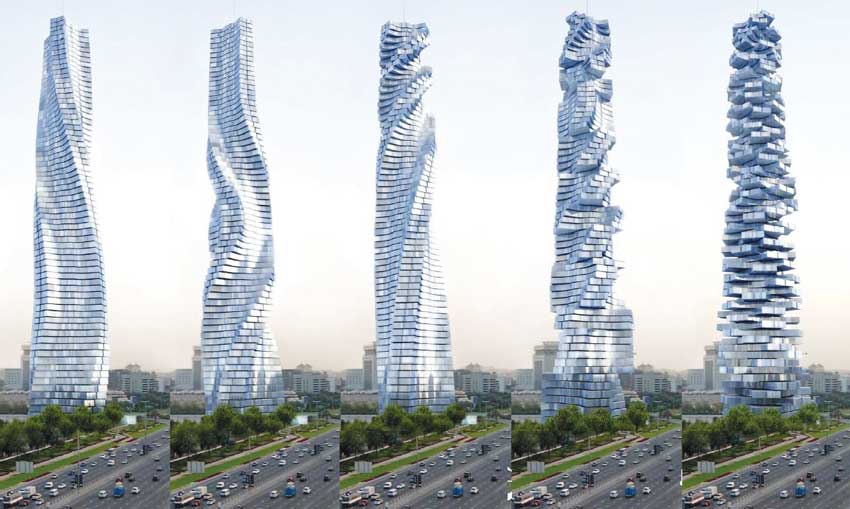
Each individual unit will be completely finished at the new Rotating Tower factory in Italy and exported worldwide. They will be equipped with all necessary plumbing and electric system, including all finishings from flooring to ceilings, bathrooms, kitchens, cabinets, lighting, and furniture.
The preassembled units are simply hooked to each other mechanically. This results in environmentally clean construction sites, avoiding unloading of materials, waste, noise and pollution. There will be less risk of accidents to construction workers, and construction time will be reduced by over 30%. Due to their particular construction method, prefabricated buildings will also be easy to maintain and repair. The building's maintenance facility, type of materials used, and the quality control employed will also make them more durable than any traditional structure.
Teatro Del Agua
As water becomes an even hotter commodity in the future, engineers are looking for ways to ensure a continued supply of fresh water to meet the needs of the world's growing population. Charles Patton is tackling this problem with his Seawater Greenhouse, a carbon-neutral de-salination method which is being incorporated into the design of the Teatrodel Agua. This Theater of Water will be a performing arts center in Spain's Canary Islands. It works by coupling a series of evaporators and condensors such that the airborne moisture from the evaporators is then collected from the condensers, which are cooled by deep seawater. The center will operate almost entirely on renewable energy.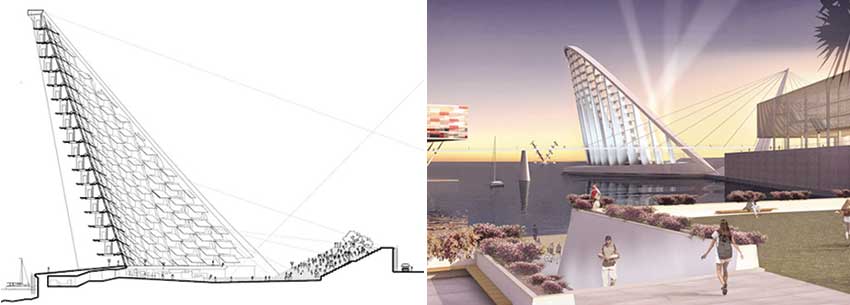
How does it work? According to Grimshaw:" The essence of the idea is to couple a series of evaporators and condensers such that the airborne moisture from the evaporators is then collected from the condensers, which are cooled by deep seawater. This produces large quantities of distilled water from seawater and is almost entirely driven by renewable energy. The structure is orientated perpendicular to the prevailing northeasterly wind to obtain a supply of ambient air. The flow rate is controlled by louvers on the leeward side, which also incorporates solar panels to provide heat for the evaporators."
Frasers Broadway
Frasers Broadway, a commercial, residential and retail complex, will be Australia's most sustainable building. The designers, including Pritzker Prize winners Foster & Partners and Ateliers Jean Nouvel, are incorporating such eco-friendly features as a gas-powered co-generation electricity plant, green rooftops, a wastewater recycling plant, smart metering and solar power into the design in an attempt to achieve carbon neutrality. The 2,50,000 square meter development will be located in the old Kent Brewery in Sydney.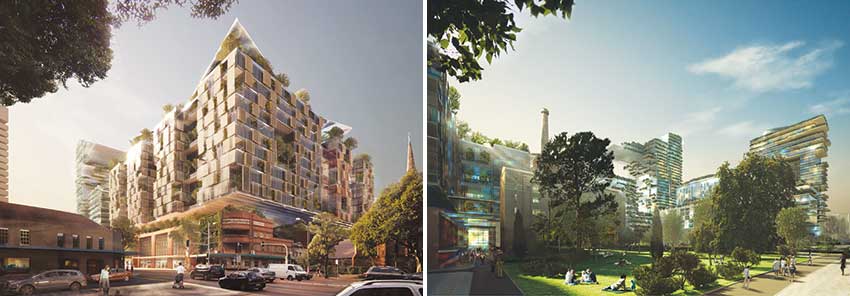
The goal of the project is to achieve carbon neutrality. To do so, the intention is to achieve and explore every design method and technology that they can get their hands on from design efficiency, to the addition of green rooftops, smart metering and solar powered lighting in public spaces. Furthermore, the project is intended to integrate with Sydney's vision of the future by becoming one of the city's "Green Transformers" – the project will be one of a number of energy generating and water recycling sites that will provide these services to their own developments and the areas nearby.
Transbay Transit Center
Pelli Clark Pelli architects recently got approval for their design for a new green Transbay Transit Center in San Francisco. The transit center will consist of a glass tower and a five-and-a-half acre public park, and will be packed with sustainable features like green roofs, passive solar shading, wind turbines, a rain and graywater recycling system and geothermal heating and cooling. The aim of the building is to centralize the region's transportation system while also providing a community space. The center will be completed by 2014.
Another Green Complex
London-based, Foster and Partners, who are also working on the aforementioned Frasers Broadway complex, have another green complex in store. This one will be located in Singapore City, measuring 150,000 square meters and set for multi-use functioning. The complex's exterior will be covered with solar cells, and direct sunlight will also be harvested by tall ribbon-like canopies rising into the skyline. The slanted design of the facades will allow wind to flow into the building for a natural cooling effect, and vertical green spaces will provide ambient temperature moderation. The building will also be equipped with a rainwater harvesting system, geothermal heating, chilled beams and an ice storage system for cooling.The complex will fill an entire city block between Singapore's Marina Center and the Civic District with commercial, residential, retail, hotels, and a ‘green' link to a Mass Rapid Transit (MRT) station. All facades will be fitted with solar cells and, to help control solar gain, direct sunlight will be filtered through ribbon-like canopies rising from the base of the entire complex to the exposed east and west elevations of the towers.
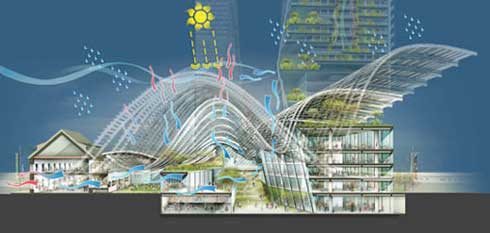
While it looks intensely complex, the design takes advantage of simple green building principles like passive solar, natural ventilation and natural cooling. Foster and Partners' dynamic design will function insynchronization with the surrounding climate, and just might be the perfect merger of elevated architecture and grounded green build thinking.
Conclusion
The benefits of building green include cost saving from reduced energy, water and waste, lower operation and maintenance cost and enhanced occupants productivity and health. However, it may include higher initial cost, but higher ROI & return on assets are the key benefits. (As indicated in actual case study).To minimize the energy consumption to a greater scale and to increase the equipment efficiency are the objectives in development of the Intelligent Green Buildings.Using fully un-interoperable systems in intelligent buildings tend to perform better, cost less to maintain, and leave a smaller environmental imprint than individual utilities and communication systems.
An emphasis therefore should be on "Green" and "clean" construction. Various agencies associated should take concentrate steps, in order to promote "Green Construction."
Refrences:
- http://www.green-tech.biz/index.php?option=com_content&view=article&id=52:grenn-buildings&catid=39:construction&Itemid=79
- http://www.jaec.info/Home%20Automation/intelligent-building-concept/intelligent-building-concept.php
- www.thehammersmithgroup.com
- http://www.fairwaycontractors.com/Products/GreenConcepts.aspx
- http://www.equa.it/images/24062008_rotatingtower_pressrelease.pdf
- http://inhabitat.com/australias-most-sustainable-development-by-foster-nouvel/
- www.architecturejournal.net
- http://www.jgarchitectural.com
- http://www.nyc.gov/html/nycwasteless/html/in_business/green_building.shtml
- http://www.fsec.ucf.edu/pvt/pvbasics
- http://www.eia.doe.gov/cneaf/solar.renewables/page/rea_data/figh1.html
- Building Design and Construction, "White Paper on Sustainability", November 2006 http://en.wikipedia.org/wiki/Sustainability
- http://homeenergy.org/archive/hem.dis.anl.gov/eehem/95/950110.html
- http://www.indoorair2002.org.
- Building for Sustainability: Six Scenarios for the David and Lucille Packard Foundation Los Altos Project," prepared for the David and Lucille Packard Foundation, http://www.packard.org/pdf/2002Report.pdf
- Report on Green Building & Sustainability Resources-August 2007-Prepared by:Cathy E. Creswell, Deputy Director Linda M. Wheaton, Assistant Deputy Director
- The Real Estate Finance Journal/Summer 2007-by Bonni F. Kaufman, Heather Pinder Rodriguez, and Shannon D. Sentman
- A Report to California's Sustainable Building Task Force -October 2003
- http://www.greenbuilder.com/sourcebook/.
- A dissertation report on "Life cycle Cost Analysis" submitted to Pune University for Master's degree by:Mr.Yevale Rohit N. under the guidance of Dr.Prof.S.S.Pimplikar.










